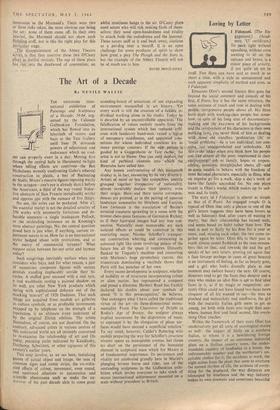The Art of a Decade
By NEVILE WALI. IS THE enormous inter- national exhibition of Paintings and Sculptures of a Decade: 54-64, org- anised by the Calouste Gulbenkian Foundation,
which has flowed' into its labyrinth of rooms and bays at the Tate Gallery until June 28, demands powers of adjustment and endurance which no stud-
ent can properly exert in a day. Moving first through, the central halls in illuminated twilight where telling effects are contrived—the Ben Nicholsons serenely confronting Gabo's ethereal construction in plastic, a bay of fluctuating de Staels; Moore's massive figures reposing warily in the octagon—one's eye is already dazed before the Americans, a third of the way round. Seduc- tive abstracts of Sam Francis inexplicably writhe and oppress one with the menace of live things. No use, the notes can be pocketed. After al, the essential matter is not,the detailed scrutiny of 350 works with necessarily fortuitous and de- batable elements—a single inadequate Pollock, or the misleading insistence on de Kooning's most abstract paintings. No, the central question Posed here is just what, if anything, current ex- periment means to us. Haw far is an international stylist hedged about with restrictions, and at the mercy of commercial, tyranny? What rapport exists between far-out artist and layman today?
Such misgivings inevitably surface when one considers who buys, and for what reason, a pair of monstrous composite figures with outsize genitals standing implacably astride their bi- cycles. A stuffed goat encased with a real tyre, a real washbasin casting a painted shadow on its wall, are other New York products which spring with sophisticated defiance out of the mocking `non-art' of 1920 Dadaism. That such things are acquired from modish art galleries as culture symbols, or as profitable investments snapped up by telephone on the strength of a reputation, is an ultimate irony undreamt of by the original Zurich nihilists. The artists themselves, of course, are not deceived. On the contrary, advanced artists in various centres of this contracted world are all intensely concerned to re-examine the relationship of art and life today, pursuing paths indicated by Kandinsky, Duchamp, Schwitters, or other signposts of this century's earlier years. This may involve, as we see here, tantalising games of actual object and image, the uses of common signs and comic strips, the co-ordin- ated effects of colour, movement, even sound, and equivocal allusions to automation and scientific phenomena such as make the en- deavour of the past decade akin to some great sounding-board of sensations of our expanding environment unequalled in art history. 'Yet every work is still the' creation of a fallible„in- dividual working alone in his studio. Today he is dwarfed by an uncontrollable apparatus. The i falsification of values entirely results from the international system which has replaced criti- cism with laudatory hand-outs, raised a legion of mercenary middlemen, and appointed com- mittees for whom individual creations are so many prestige counters. If the new patron is guided by a GUggenheim or Tate' cachet, the artist is not to blame. One can only deplore the kind of purblind clientele into which the Biennales have called him.
Any honest confrontation of this mammoth display is, in fact, reassuring'by its very diversity. Artists. of mote- or less like synipathies, usually grouped 'together'' irrespective of nationality, almost invariably declare their identity, even their origin. Here and there native correspon- dences are pointed, as in the pairing of aqueous ' landscape summaries by Hitchens. and Lanyon. Less fortunate is the: association of Bacon's tortured creatures sprawling in a room with the bronze chess-piece fantasies of Germaine Richier, as if their lacerated images had any true con- nection. Naturally most memorable are such isolated effects as could be contrived in this restricting maze. Nicolas Schaffer's transpar- ent construction whirring and coruscating in coloured light like some revolving palace of the future has all the space it requires. Distantly flanked by Tinguely's machine and consorting with Mathieu's huge pyrotechnic canvas, this triumvirate dominating a vestibule shows that Paris still has punches of her own.
Every recent development in sculpture, whether of mobility or of structures incorporating colour or alien matter, has represented a conquest and posed a dilemma. Herbert Read has frankly declared his doubts about new symbols of speed. 'It is this preoccupation,' he believes, `that endangers what I have called the traditional virtue of the art—its three-dimensional monu- mentality. From The Charioteer of Delphi to Rodin's Age of Bronze, the sculptor always implied movement by the disposition of mass; to represent it by the elongation of plane sur- faces would have seemed a superficial solution.' To my mind, however, Calder's fluttering wire mobile preparing the way for Schaffer's structure vivante opens an inescapable avenue, but closes no door on the persistence of the humanist element in sculptural mass which for Moore is of fundamental importance. Its persistence and vitality are celebrated grandly here in Marini's plunging bronze horse and rider, one of the oustanding sculptures in the Gulbenkian exhi- bition which invites everyone to take stock of recent international achievement mounted on a scale without precedent in Britain.














































 Previous page
Previous page